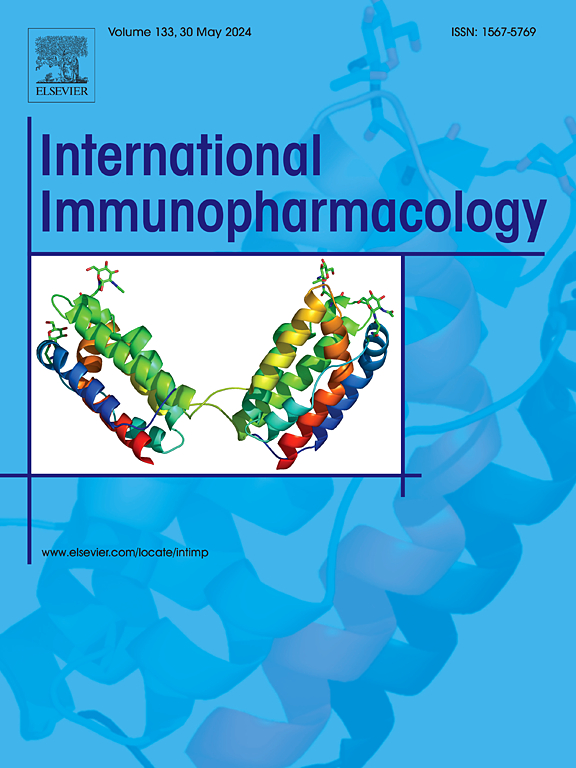3,6-Anhydro-L-galactose suppresses mouse lymphocyte proliferation by attenuating JAK-STAT growth factor signal transduction and G1-S cell cycle progression
IF 4.8
2区 医学
Q2 IMMUNOLOGY
引用次数: 0
Abstract
Recombinant GH16B β-agarase-catalyzed liquefaction of 5–7 %(w/v) melted agarose at 50 °C completely hydrolyzed agarose into neoagarohexaose (NA6) and neoagarotetraose (NA4). Subsequent saccharification by recombinant GH50A β-agarase or recombinant GH50A β-agarase/recombinant GH117A α-neoagarobiose hydrolase at 35 °C converted NA6/NA4 into neoagarobiose (NA2) or 3,6-anhydro-L-galactose (L-AHG)/D-galactose, respectively. Purification of NA6/NA4 and NA2 was achieved by Sephadex G-15 column chromatography, while L-AHG was purified by Sephadex G-10, achieving ≥ 98 % purity. L-AHG (25–200 μg/mL), but not NA2, NA4, or NA6, inhibited the proliferation of immobilized anti-CD3/anti-CD28-activated T cells and immobilized anti-CD40 + soluble anti-IgM + interleukin (IL)-4-activated B cells. This inhibition impacted the G1-S traverse in the cell cycle without influencing CD69 expression and p27Kip1 down-regulation, markers of the exit from G0 into G1 phase in activated lymphocytes. L-AHG impeded cyclin-dependent kinases (CDKs)-driven retinoblastoma phosphorylation, necessary for the G1-S traverse, by reducing the activating phosphorylation of CDKs (CDK4, CDK2, and CDK1) and lowering cyclin D3, cyclin A2 and cyclin B1 levels. Furthermore, L-AHG diminished the production of growth factors, including IL-2 in activated T cells and IL-6 in activated B cells. The antiproliferative effect of L-AHG on T cells was partially restored by exogenous IL-2 but was unaffected by exogenous IL-6 on B cells. L-AHG inhibited the activating phosphorylation of Janus kinase 1 (JAK1), affecting signal transducer and activator of transcription 1 (STAT1) and STAT3 signaling. These results demonstrate that L-AHG may serve as a novel immunosuppressant by impairing JAK-STAT growth factor signaling and G1-S cell cycle progression in T and B lymphocytes.

求助全文
约1分钟内获得全文
求助全文
来源期刊
CiteScore
8.40
自引率
3.60%
发文量
935
审稿时长
53 days
期刊介绍:
International Immunopharmacology is the primary vehicle for the publication of original research papers pertinent to the overlapping areas of immunology, pharmacology, cytokine biology, immunotherapy, immunopathology and immunotoxicology. Review articles that encompass these subjects are also welcome.
The subject material appropriate for submission includes:
• Clinical studies employing immunotherapy of any type including the use of: bacterial and chemical agents; thymic hormones, interferon, lymphokines, etc., in transplantation and diseases such as cancer, immunodeficiency, chronic infection and allergic, inflammatory or autoimmune disorders.
• Studies on the mechanisms of action of these agents for specific parameters of immune competence as well as the overall clinical state.
• Pre-clinical animal studies and in vitro studies on mechanisms of action with immunopotentiators, immunomodulators, immunoadjuvants and other pharmacological agents active on cells participating in immune or allergic responses.
• Pharmacological compounds, microbial products and toxicological agents that affect the lymphoid system, and their mechanisms of action.
• Agents that activate genes or modify transcription and translation within the immune response.
• Substances activated, generated, or released through immunologic or related pathways that are pharmacologically active.
• Production, function and regulation of cytokines and their receptors.
• Classical pharmacological studies on the effects of chemokines and bioactive factors released during immunological reactions.

 求助内容:
求助内容: 应助结果提醒方式:
应助结果提醒方式:


